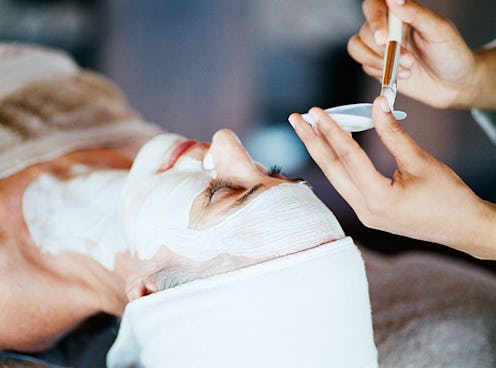Fashion
6 Things A Great Esthetician Would Never Tell You

Facials, while sometimes painful, have the power to seriously transform your skin. Using a combination of steam, scrubs, cleansers, and extractions, facials can make skin less prone to acne and have major anti-aging benefits. There are a bunch of things you should know before you get your first facial, but how are you supposed to know if your facialist is legit? And on that note, are there certain things your esthetician won't tell you during an appointment? What's a girl or guy got to do to get a good facial around here? Educate yourself first, that's what.
We talked to an expert at Murad skincare, which carries products for young people with acne-prone skin, older women who want anti-aging products, and every age in between. The company also partners with Massage Envy to offer Murad Healthy Skin facials at its locations. Its experts are trained to handle any skin conundrum, but not every esthetician is trained according to the same rigorous standards. Although any facial will make your skin feel clean, it's hard to tell if you're actually reaping the benefits a good facial can offer. The experts at Murad are committed to providing the best facial services on the market, so they told us the things an experienced esthetician would never say.
1. You should get a professional facial on a weekly basis
Facials are expensive, and a good one will run usually run you at least $50. That's a decent amount of money to invest in skincare, so you want to make sure you're going often enough to really see improvement in your skin. That said, unless otherwise told by your esthetician, it's likely not necessary to get a professional facial on a weekly basis. In other words, too much of a good thing might not be a good thing for your skin at all. According to Murad, having a facial every six to eight weeks ensures the most consistent results.
2. All facials are the same
Going to your first facial can be intimidating enough, so it's hard to tell your esthetician what type of facial you want without having prior experience. Any good esthetician will tell you that a facial should be tailored to your skin and its unique needs. Estheticians at Massage Envy offer four types of facials, including an Environmental Shield Vitamin C Facial, one for acne-prone skin, one for people who want anti-aging products and one for people with sensitive skin. A good esthetician will ask you lots of questions about your skin to make sure you're getting the best service possible.
3. You should only get facials in the summer, when skin tends to be oily
Summer weather tends to bring oily skin and breakouts, but skin is often less acne-prone in the winter. This doesn't mean you shouldn't be getting regular facials throughout the year. The best way to see the benefits of facials is to be consistent about getting them. A good facial will feature products that help your skin deal with whatever weather your area has, so winter isn't an excuse to skip out.
4. You should perform extractions on your own skin between facials
Extractors are tiny metal lasso-like tools that your esthetician may use to clean out your pores or occasionally pop a pimple. Extractions are one of the trademarks of a good facial, but they can be painful. This is one task you definitely want to leave to the professionals. Even though you can buy extractor tools online, it's not a good idea to try and perform extractions on your own skin. If it's done wrong, this can lead to scarring on your face, which is the last thing you want.
5. If you're under 30, you should skip retinols and get peels regularly
Retinol is an at-home product that you apply topically, and it has major anti-aging properties. Retinol contains Vitamin A, which encourages cell turnover and removes dead skin cells, according to the experts at Murad. It's one of the best ways to exfoliate at home. Peels on the other hand, are performed by an esthetician or dermatologist and can take weeks to recover from. Gentle peels can be effective on acne-prone skin, but most peels are designed for aged skin. If you're under 30 and don't have acne, you should probably find a retinol instead of investing in peels.
6. Your skin will look great immediately following a facial
Everyone knows how it feels to walk out of a facial with reddened skin that sometimes looks worse than when you got there. This tends to fade quickly and you typically notice an improved appearance to your skin. However, don't freak out if your skin goes through a "purging" phase after your facial and you start to break out. According to Murad, facials are designed to clear toxins deep in the skin, and some of those toxins may appear as whiteheads or pimples. It's completely normal, and they typically don't last long. Your skin will be clear in a few days, convincing you that facials are totally worth it and should be a necessary part of your beauty routine.
Images: FoundryParkInn; Zenspa1; FoundryParkInn; FoundryParkInn/Flickr